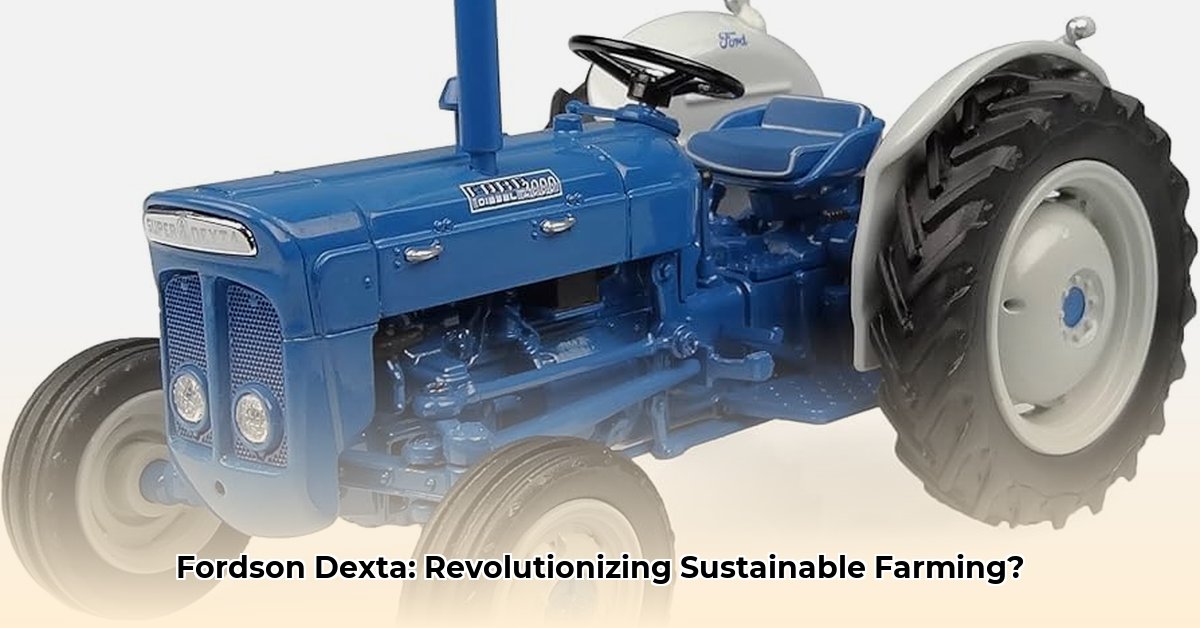
The Fordson Dexta, a compact tractor produced from 1957 to 1964, holds a significant place in agricultural history. More than just a machine, it represents a pivotal moment in the mechanization of farming, particularly for smaller-scale operations. Its enduring legacy, however, is intertwined with both its achievements and limitations regarding sustainable agricultural practices. For more information on Ford tractors, check out this useful resource.
The Dexta's Rise: Affordability and Accessibility
Introduced in 1957, the Fordson Dexta quickly gained popularity due to its blend of affordability and practicality. Offering a choice of diesel or gasoline engines (8.4 gallons for diesel and 11.4 for gasoline), it catered to diverse fuel availability across different regions. Its 32 horsepower, while modest by today's standards, provided sufficient power for many farming tasks, particularly on smaller farms. The over 928,000 units produced by 1964 underscore its widespread adoption and substantial impact on global agriculture. This accessibility arguably democratized mechanized farming, empowering numerous smallholder farmers to increase productivity.
Simple Design, Enduring Impact: Technology and Legacy
The Dexta's design reflected its era. Manual steering, mechanical brakes, and an open operator station characterized its functionality. While lacking the safety and comfort features of modern tractors, this simplicity proved advantageous in terms of maintenance and repair—crucial factors for farmers who relied on equipment reliability. The open operator station, for example, provided excellent visibility, a feature appreciated by farmers. The easy maintenance aspect contributed to its widespread acceptance and use in various farming settings.
However, this simplicity also meant limitations. The Dexta's technology was less sophisticated than later models, restricting its versatility and operational capabilities in comparison to modern counterparts. Yet, its inherent simplicity made it a durable and easily maintainable workhorse for many, a design element that extended its lifespan and usage among farmers.
A Balanced Perspective: Strengths and Weaknesses
The Fordson Dexta's legacy is complex. It was not without its drawbacks, even while it was revolutionary for its time.
| Feature | Pros | Cons |
|---|---|---|
| Power & Efficiency | Relatively fuel-efficient for its time; offered both diesel and gasoline options | Lower horsepower than modern tractors; potential lower actual power output compared to advertised specifications. |
| Design & Features | Simple design, easy to maintain; excellent operator visibility | Lack of modern safety and comfort features; manual steering and brakes; basic controls |
| Impact & Legacy | High production volume; significant global impact; democratized agricultural technology | Technological limitations compared to later models; limited versatility in various terrains. |
The Dexta's Influence on Sustainable Farming: A Deeper Look
While the Fordson Dexta contributed to increased agricultural productivity, its design limitations also impacted the adoption of sustainable practices. Its lower horsepower often necessitated more passes over fields, potentially increasing fuel consumption and soil compaction. The limited hydraulic capacity restricted implement choices, potentially hindering the use of tools designed for soil conservation or precision farming. Furthermore, its smaller size frequently meant that farmers with larger holdings needed multiple Dextas, raising overall operational costs and resource consumption beyond the initial cost of the machine itself. The Super Dexta attempted to address some of these limitations, boasting a larger engine and increased hydraulic capacity, but fundamental design constraints inherent to its era remained a significant factor.
The Fordson Dexta's Enduring Legacy: A Continuing Conversation
Despite its technological limitations, the Fordson Dexta's impact remains undeniable. It democratized agricultural mechanization, empowering farmers across the globe. Its story continues to be explored and studied, prompting ongoing discussions around the evolution of agricultural technology and its interaction with sustainable farming practices. "The Dexta's influence on smallholder farming is remarkable, showing the role simple but effective technology can play in boosting productivity and improving livelihoods," observes Dr. Anya Sharma, Agricultural Historian at the University of Cambridge. The machine stands as a testament to the inherent tension between technological advancements and the broader goals of sustainable agriculture, a tension that continues to shape the industry to this day.